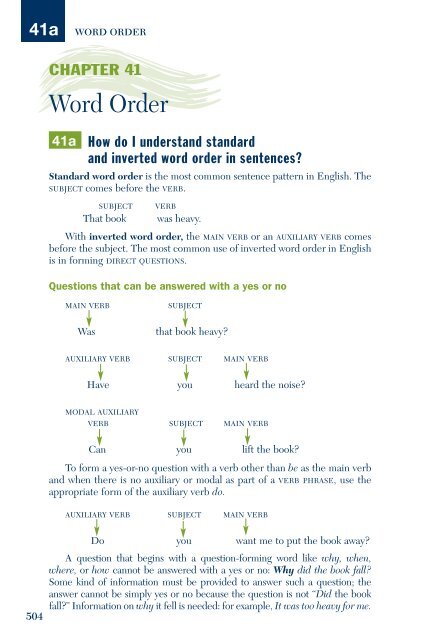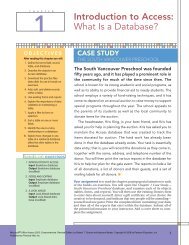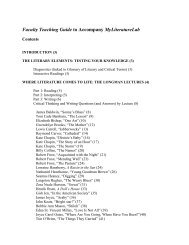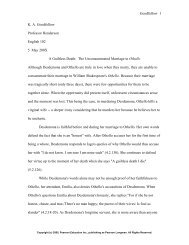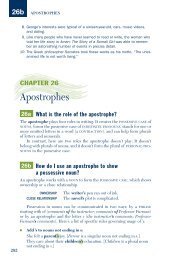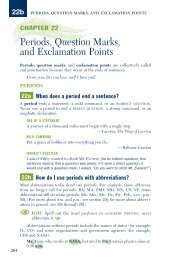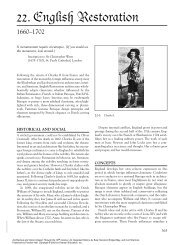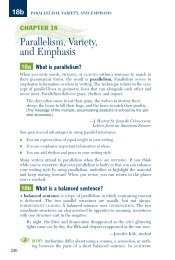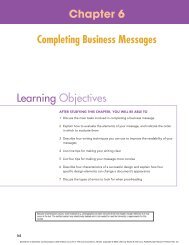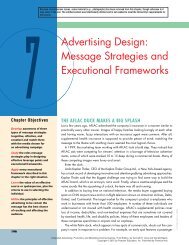Chapter 41: Word Order eBook
Chapter 41: Word Order eBook
Chapter 41: Word Order eBook
You also want an ePaper? Increase the reach of your titles
YUMPU automatically turns print PDFs into web optimized ePapers that Google loves.
<strong>41</strong>a<br />
WORD ORDER<br />
CHAPTER <strong>41</strong><br />
<strong>Word</strong> <strong>Order</strong><br />
<strong>41</strong>a<br />
How do I understand standard<br />
and inverted word order in sentences?<br />
Standard word order is the most common sentence pattern in English. The<br />
SUBJECT comes before the VERB.<br />
SUBJECT<br />
VERB<br />
That book was heavy.<br />
With inverted word order, the MAIN VERB or an AUXILIARY VERB comes<br />
before the subject. The most common use of inverted word order in English<br />
is in forming DIRECT QUESTIONS.<br />
Questions that can be answered with a yes or no<br />
MAIN VERB<br />
Was<br />
SUBJECT<br />
that book heavy?<br />
AUXILIARY VERB SUBJECT MAIN VERB<br />
Have you heard the noise?<br />
MODAL AUXILIARY<br />
VERB SUBJECT MAIN VERB<br />
Can you lift the book?<br />
To form a yes-or-no question with a verb other than be as the main verb<br />
and when there is no auxiliary or modal as part of a VERB PHRASE, use the<br />
appropriate form of the auxiliary verb do.<br />
AUXILIARY VERB SUBJECT MAIN VERB<br />
Do you want me to put the book away?<br />
A question that begins with a question-forming word like why, when,<br />
where, or how cannot be answered with a yes or no: Why did the book fall?<br />
Some kind of information must be provided to answer such a question; the<br />
answer cannot be simply yes or no because the question is not “Did the book<br />
fall?” Information on why it fell is needed: for example, It was too heavy for me.<br />
504
How do I understand standard and inverted word order in sentences?<br />
<strong>41</strong>a<br />
Information questions: Inverted order<br />
Most information questions follow the same rules of inverted word order as<br />
yes-or-no questions.<br />
QUESTION<br />
WORD MAIN VERB SUBJECT<br />
Why is that book open?<br />
QUESTION AUXILIARY<br />
WORD VERB SUBJECT MAIN VERB<br />
What does the book discuss?<br />
QUESTION MODAL<br />
WORD AUXILIARY SUBJECT MAIN VERB<br />
When can I read the book?<br />
Information questions: Standard order<br />
When who or what functions as the subject in a question, use standard word<br />
order.<br />
QUESTION WORD: SUBJECT<br />
MAIN VERB<br />
Who<br />
QUESTION WORD: SUBJECT<br />
dropped the book?<br />
MAIN VERB<br />
What<br />
was the problem?<br />
ALERT: When a question has more than one auxiliary verb, put the<br />
subject after the first auxiliary verb.<br />
FIRST SECOND MAIN<br />
AUXILIARY SUBJECT AUXILIARY VERB<br />
Would you have replaced the book?<br />
The same rules apply to emphatic exclamations: Was that book heavy!<br />
Did she enjoy that book!<br />
505
<strong>41</strong>b<br />
WORD ORDER<br />
Negatives<br />
When you use negatives such as never, hardly ever, seldom, rarely, not only,<br />
or nor to start a CLAUSE, use inverted order. These sentence pairs show the<br />
differences, first in standard order and then in inverted order.<br />
I have never seen a more exciting movie. [standard order]<br />
Never have I seen a more exciting movie. [inverted order]<br />
She is not only a talented artist but also an excellent musician.<br />
Not only is she a talented artist, but she is also an excellent musician.<br />
NO<br />
YES<br />
ALERTS: (1) With INDIRECT QUESTIONS, use standard word order.<br />
She asked how did I drop the book.<br />
She asked how I dropped the book.<br />
(2) <strong>Word</strong> order deliberately inverted can be effective, when used sparingly,<br />
to create emphasis in a sentence that is neither a question nor an exclamation<br />
(also see 18j).<br />
<strong>41</strong>b<br />
How can I understand the placement<br />
of adjectives?<br />
ADJECTIVES modify—describe or limit—NOUNS, PRONOUNS, and word groups<br />
that function as nouns (see 7e). In English, an adjective comes directly<br />
before the noun it describes. However, when more than one adjective<br />
describes the same noun, several sequences may be possible.Box <strong>41</strong>-1 shows<br />
the most common order for positioning several adjectives.<br />
BOX <strong>41</strong>-1<br />
SUMMARY<br />
<strong>Word</strong> order for more than one adjective<br />
506<br />
1. Determiners, if any: a, an, the, my, your, this, that, these, those, and<br />
so on<br />
2. Expressions of order, including ordinal numbers, if any: first,<br />
second, third, next, last, final, and so on<br />
3. Expressions of quantity, including cardinal (counting) numbers,<br />
if any: one, two, few, each, every, some, and so on<br />
4. Adjectives of judgment or opinion, if any: pretty, happy, ugly, sad,<br />
interesting, boring, and so on<br />
5. Adjectives of size or shape, if any: big, small, short, round, square,<br />
and so on<br />
➞
How can I understand the placement of adverbs?<br />
<strong>41</strong>c<br />
<strong>Word</strong> order for more than one adjective (continued)<br />
6. Adjectives of age or condition, if any: new, young, broken, dirty,<br />
shiny, and so on<br />
7. Adjectives of color, if any: red, green, blue, and so on<br />
8. Adjectives that can also be used as nouns, if any: French,<br />
Protestant, metal, cotton, and so on<br />
9. The noun<br />
1 2 3 4 5 6 7 8 9<br />
a few tiny red ants<br />
the last six Thai carvings<br />
my fine old oak table<br />
<strong>41</strong>c<br />
How can I understand the placement<br />
of adverbs?<br />
ADVERBS modify—describe or limit—VERBS, ADJECTIVES, other adverbs, or<br />
entire sentences (see 7f). Adverbs may be positioned first, in the middle, or<br />
last in CLAUSES. Box <strong>41</strong>-2 summarizes adverb types, what they tell about the<br />
words they modify, and where each type can be placed.<br />
BOX <strong>41</strong>-2<br />
SUMMARY<br />
Types of adverbs and where to position them<br />
ADVERBS describe how Nick carefully<br />
OF MANNER something is done groomed the dog.<br />
are usually in middle<br />
or last position<br />
Nick groomed<br />
the dog carefully.<br />
ADVERBS describe when or how First, he shampooed<br />
OF TIME long about an event the dog.<br />
are usually in first or He shampooed<br />
last position<br />
the dog first.<br />
include just, still,<br />
He had already<br />
already, and similar brushed the dog’s coat.<br />
adverbs, which are usually<br />
in middle position<br />
➞<br />
507
<strong>41</strong>c<br />
WORD ORDER<br />
Types of adverbs and where to position them<br />
(continued)<br />
ADVERBS OF describe how often an Nick has never been<br />
FREQUENCY event takes place bitten by a dog.<br />
are usually in middle<br />
position<br />
are in first position when Occasionally, he is<br />
they modify an entire scratched while<br />
sentence (see “Sentence shampooing a cat.<br />
adverbs” below)<br />
ADVERBS OF describe how much or Nick is extremely<br />
DEGREE OR to what extent about other calm around animals.<br />
EMPHASIS modifiers [Extremely modifies calm.]<br />
are directly before the<br />
word they modify<br />
include only, which is easy<br />
to misplace (see 14a)<br />
SENTENCE modify the entire sentence Incredibly, he was<br />
ADVERBS rather than just one word once asked to groom<br />
or a few words<br />
a rat.<br />
include transitional words<br />
and expressions (see 4g.1),<br />
as well as such expressions<br />
as maybe, probably, possibly,<br />
fortunately, unfortunately,<br />
and incredibly<br />
are in first position<br />
ALERT: Do not let an adverb separate a verb from its DIRECT OBJECT<br />
or INDIRECT OBJECT.<br />
EXERCISE <strong>41</strong>-1 Consulting all sections of this chapter, find and correct any<br />
errors in word order.<br />
1. For two hundred years almost, the North Pacific humpback whales have<br />
returned to the tropic waters of Hawaii.<br />
2. Why they are returning to these particular waters year after year?<br />
3. The humpbacks do not accidentally arrive in Hawaiian waters; they are<br />
precise extremely in searching for this specific location, where they gather<br />
to complete their breeding rituals.<br />
508
How can I recognize prepositions?<br />
42a<br />
4. The whales first to arrive are sighted sometime in late November, after<br />
completing a 3,000-mile journey.<br />
5. The humpbacks last to migrate to Hawaii arrive by December late or<br />
January early.<br />
EXERCISE <strong>41</strong>-2 Consulting all sections of this chapter, find and correct<br />
any errors in word order.<br />
1. A beautiful few flowers began to bloom in my garden this week.<br />
2. A neighbor asked me, “You did grow all these yourself?”<br />
3. “Yes,” I replied, “the roses are my favorite husband’s, but the tulips are my<br />
favorite.”<br />
4. My neighbor, who extremely was impressed with my gardening efforts,<br />
decided to grow some flowers of her own.<br />
5. Weeks later, as I strolled by her house, I saw her planting happily seeds<br />
from her favorite type of plant—petunias.<br />
CHAPTER 42<br />
Prepositions<br />
Prepositions function with other words in PREPOSITIONAL PHRASES (7n).<br />
Prepositional phrases usually indicate where (direction or location), how (by<br />
what means or in what way), or when (at what time or how long) about the<br />
words they modify.<br />
This chapter can help you with several uses of prepositions, which function<br />
in combination with other words in ways that are often idiomatic—that<br />
is, peculiar to the language. The meaning of an IDIOM differs from the literal<br />
meaning of each individual word. For example, the word break usually refers<br />
to shattering, but the sentence Yao-Ming broke into a smile means that a<br />
smile appeared on Yao-Ming’s face. Knowing which preposition to use in a<br />
specific context takes much experience in reading, listening to, and speaking<br />
the language. A dictionary such as the Longman Dictionary of Contemporary<br />
English or the Oxford Advanced Learner’s Dictionary can be especially<br />
helpful when you need to find the correct preposition to use in cases not<br />
covered by this chapter.<br />
42a<br />
How can I recognize prepositions?<br />
Box 42-1 on the next page lists many common prepositions.<br />
509


